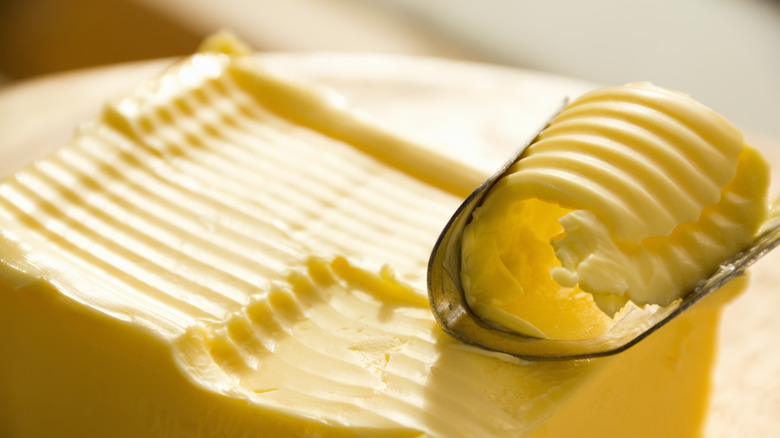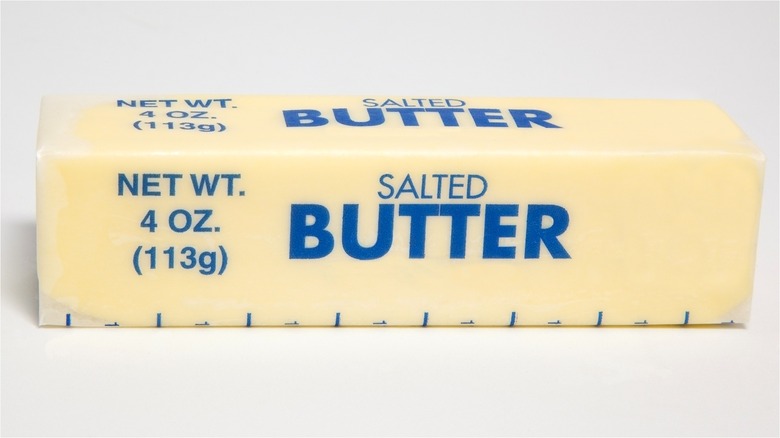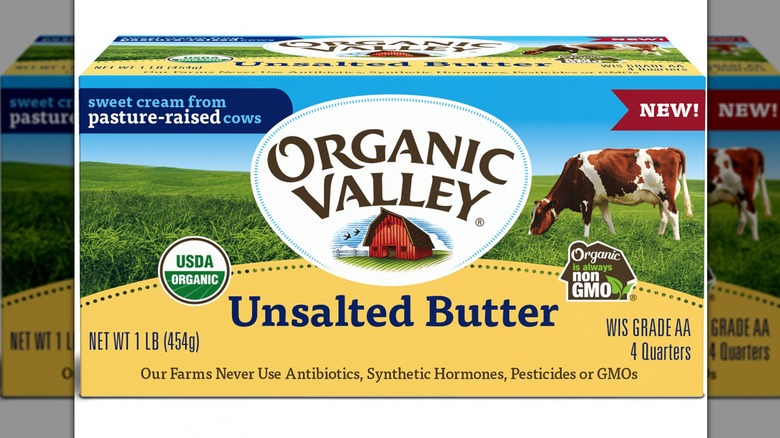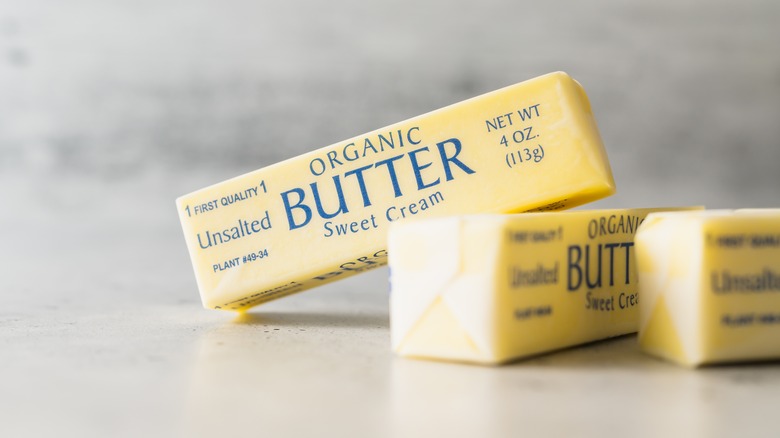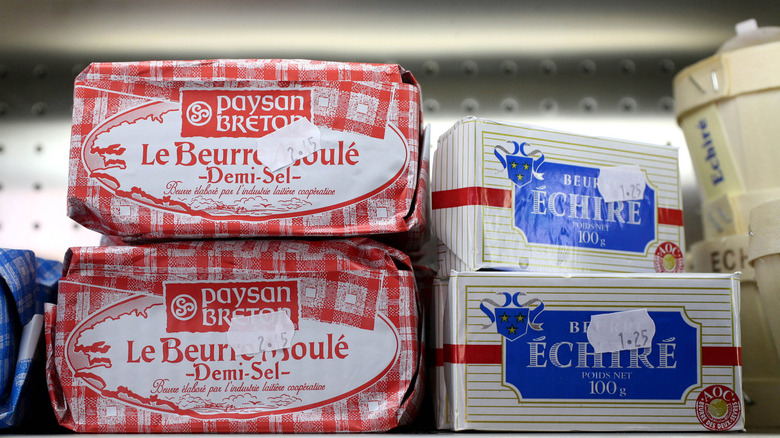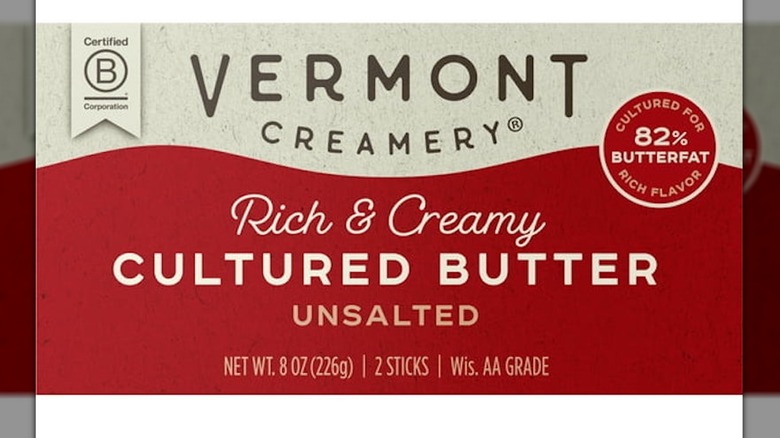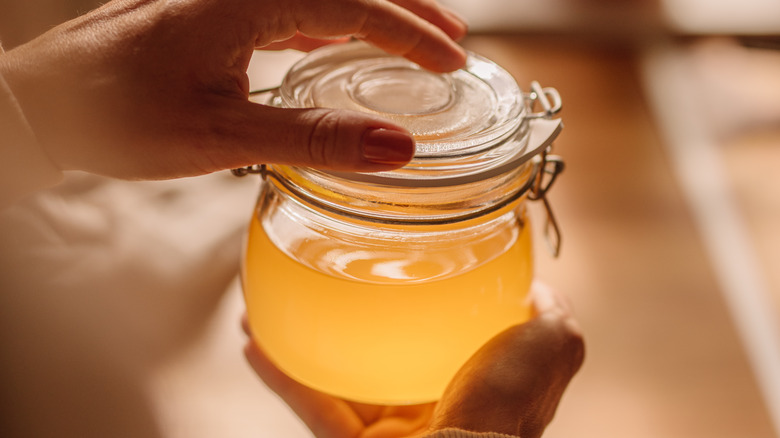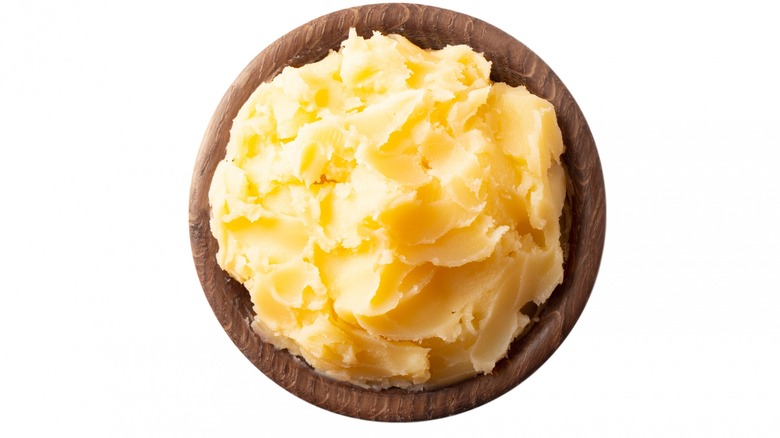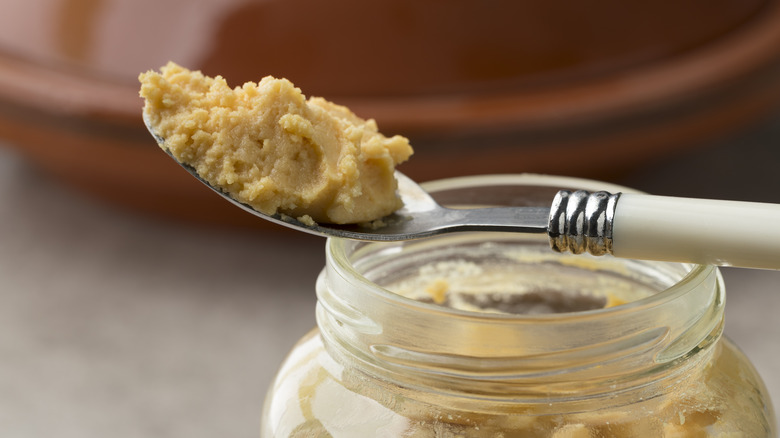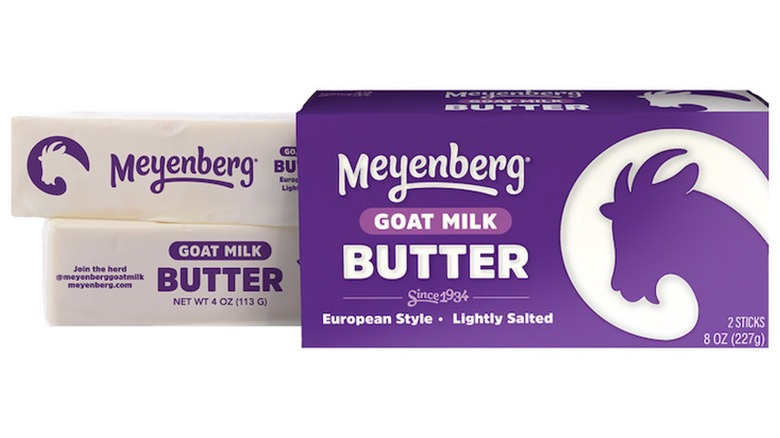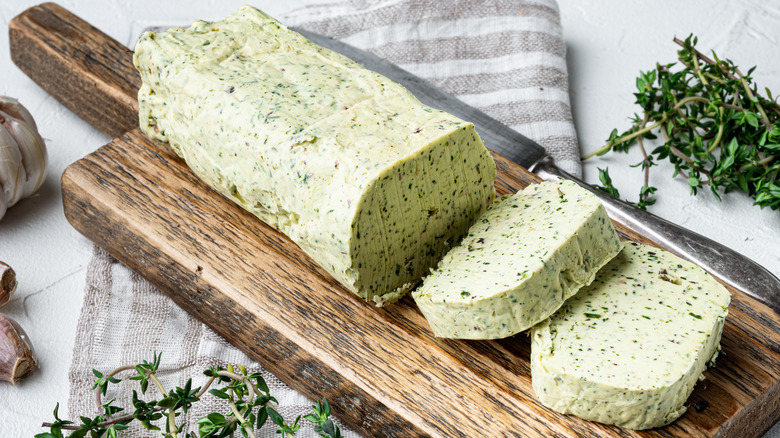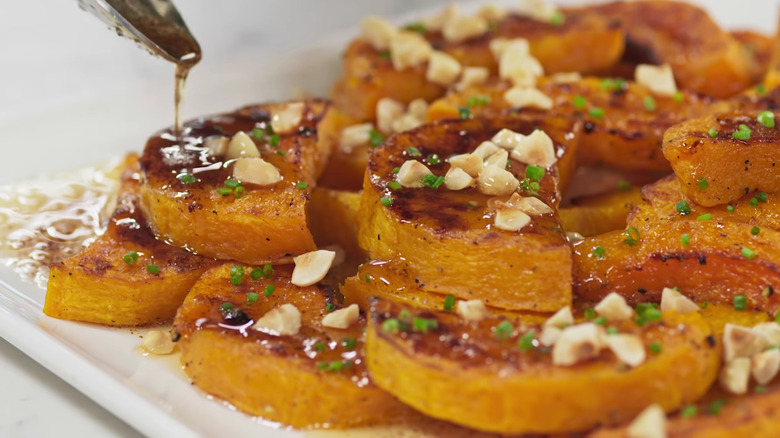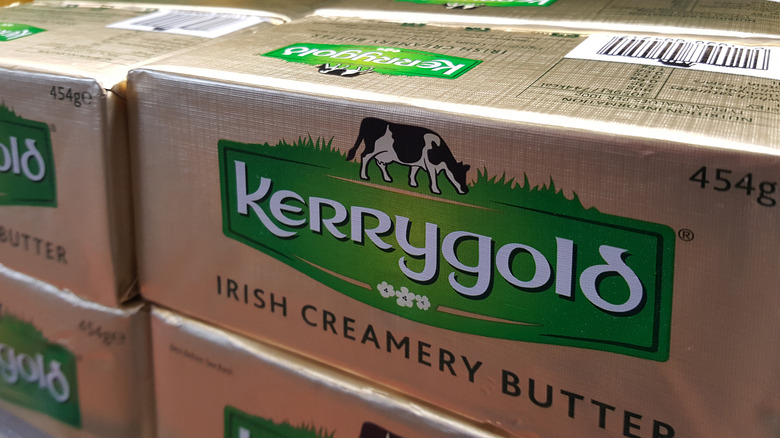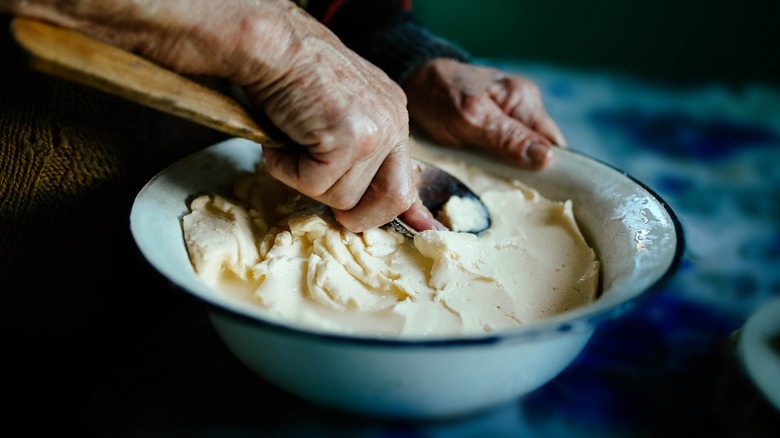13 Types Of Butter And When You Should Use Them
Butter is an essential ingredient for many dishes, cuisines, and cooking styles. This is perhaps most evident when it comes to baking. After all, where would the world of baking be without a humble block of butter? Outside of forming doughs and batters, many chefs rely on butter to perform a whole host of tasks, from lubricating pots and pans to adding a luxurious final flourish to dishes. It is this versatility that makes butter so widely adored.
At its most basic, butter is a dairy product made from the condensed fat of milk or cream. Butter can, however, take many forms. Many of these unique styles have arisen over time to meet particular needs. For example, the high smoke point of ghee makes it perfectly suited for the hot cooking process associated with making a tadka.
While necessary, this huge range of butter styles can be confusing. In this article, we detail the characteristics and uses of 13 prevalent types of butter, so you can select the correct one every time you're in the kitchen.
1. Salted butter
Even those who seldom cook will be aware that butter is available in either salted or unsalted forms. The former, as the name suggests, is simply butter that has had salt added during the production process. This added salt serves two main purposes. Firstly, it acts as a preservative by inhibiting the growth of potentially harmful bacteria. As a result, salted butter is much less likely to spoil when left out on the counter. This makes it an ideal choice for spreading, as it can be allowed to soften without turning rancid.
The second reason for adding salt during the production process is to bring extra flavor to the butter and anything that is cooked with it. This characteristic makes salted butter particularly suited to low-temperature sautéing.
As the amount of salt added to the butter varies from brand to brand, it does give those using it less control over the final dish. This can be an issue for cooking that requires great accuracy, such as baking. What's more, salted butter is not the best option for making sweet treats, as the salt can clash unpleasantly with sugar.
That being said, as a widely available and uncomplicated butter style, salted butter is typically cheap and frequently used. No pantry would be complete without it.
2. Unsalted butter
Unsalted butter is the simplest style of butter. It's made without the addition of any ingredients and is therefore composed solely of butterfat, milk proteins, and water. The simplicity inherent to unsalted butter makes it incredibly versatile and, as such, it is a foundational ingredient in cuisines from around the world.
Unsalted butter particularly excels in baking, as it gives the baker complete control over the salt content of a recipe. What's more, unsalted butter nearly always contains less water than salted butter. This is a benefit for bakers, as higher moisture levels can prevent gluten from developing.
As it contains no added salt, unsalted butter is also slightly healthier than salted butter. For those with high blood pressure, swapping salted butter for unsalted butter can be an easy way to improve their diet and subsequent health.
Although it lacks additional salt, unsalted butter does not always lack flavor. Well-made unsalted butter can be incredibly tasty. Some people even suggest that unsalted butter demonstrates the purest flavor of any butter. As with salted butter, unsalted is readily available at most grocery stores for low prices.
3. Sweet cream butter
Sweet cream butter, which is often called American butter, is made with pasteurized cream and salt, although it does come in unsalted versions too. Pasteurization ensures that potentially harmful bacteria are killed. A potential side effect of this process, however, is a change in how the cream — and subsequent butter — tastes. Sweet cream butter that has been made from cream that's undergone a long pasteurization process may have a burnt or cooked flavor. Well-prepared sweet cream butter tastes mild.
Unlike European butter, sweet cream butter usually contains only 80% butterfat, as this is the minimum amount stipulated by the United States Department of Agriculture. A lower percentage of butterfat results in sweet cream butter having a lower smoke point than many other kinds of butter. As a result, sweet cream butter is ill-suited to high-temperature cooking techniques.
As a neutral-tasting, readily available, and cheap option, sweet cream butter is widely used by home cooks. It should be considered a jack-of-all-trades and is used in almost every culinary setting. Yet, it does lack the distinct characteristics that make other butters so remarkable.
4. European butter
Unlike sweet cream butter, European butter is often made with cultured cream. This is cream that contains live bacteria. Usually, the cream is churned for a longer period when making European butter, producing a butter that is higher in fat. The European Union defines unsalted butter as having a minimum butterfat content of 82%. Salted butter must be at least 80% butterfat. In both instances, butterfat content can go up to 90%. As a result, European butter also carries more flavor than sweet cream butter.
This higher fat content makes European butter a favorite of bakers worldwide. The reason for this was explained to Pastry Arts Magazine by Kierin Baldwin, chef-instructor of Pastry & Baking Arts at the Institute of Culinary Education: "Any type of recipe that depends on the fat in butter for either leavening or shortness will do best with a high fat butter. Things that fall into these categories are laminated doughs, such as puff pastry, croissant and Danish; pie doughs and other flaky cut-in butter preparations; and creamed butter cakes and cookies."
Superior flavor also means that European butter is a fantastic option when it comes to finishing dishes. From risotto to steak, a final knob of European butter adds extra complexity that the addition of sweet cream butter does not.
As a specialist product, European butter is generally more expensive than its American counterpart. Fortunately, Americans don't need to purchase imported butter from European brands; many American dairies are making exceptional European-style butter.
5. Cultured butter
Cultured butter is butter that has had live cultures added to it prior to churning. This can happen through the addition of a starter or by simply allowing the cream to ferment. However it is introduced, the live bacterial culture drastically changes the butter's flavor.
Instead of being mellow, cultured butter is sharp with a distinctive bite and unparalleled richness. It's so different that some describe it as being more akin to cheese than regular butter. Due to this intense flavor, cultured butter is best spread on bread to be enjoyed before a meal; an appetizer favored by many restaurants.
Aside from being flavorful, cultured butter also has some healthy properties. Thanks to the presence of bacteria, cultured butter is full of probiotics which promote a healthy gut microbiome.
Cultured butter can be found in most grocery stores and some brands that make it, like Vermont Creamery, are not that expensive. That being said, cultured butter is nearly always priced higher than sweet cream butter.
6. Clarified butter
Clarified butter is made from 99 to 100% butterfat. To make it, milk proteins and water are separated from the butterfat by gently melting the butter. The liquid butterfat is then separated from the milk solids by straining, such as through a muslin cloth.
The removal of both the milk solids and water drastically raises the butter's smoke point. Clarified butter has a smoke point of approximately 450 degrees Fahrenheit. For comparison, sweet cream butter's smoke point sits around 350 degrees Fahrenheit. This high smoke point ensures that clarified butter is well-suited to high-temperature cooking techniques like searing; the butter will not burn and ruin the flavor of the food.
French cuisine relies heavily on clarified butter. It is used to preserve potted prawns and is included in many celebrated French sauces including hollandaise.
Clarified butter contains only trace amounts of lactose. Consequently, it is a butter that can be enjoyed by those who have lactose intolerances. Unfortunately, clarified butter is not available at many grocery stores. It is, however, simple to make at home.
7. Ghee
Ghee is a type of clarified butter that is cooked after separating and before straining. Different brands, families, countries, and cultures cook the ghee to varying degrees. Although each version of ghee will taste slightly different, all will share a distinct, nutty flavor.
Similarly to clarified butter, ghee has a smoke point of 450 degrees Fahrenheit and is perfect for high-temperature cooking. In Indian cuisine this is epitomized through its use in tadka, the process of blooming spices in hot ghee, resulting in an aromatic oil. Other South Asian cultures use ghee in a variety of ways, including in the preparation of breads, sweets, and desserts.
While it can be difficult to find clarified butter in grocery stores, ghee is widely available. One of the reasons ghee is so prevalent across the world is its purported health benefits; this butter has been an integral part of Ayurvedic medicine for millennia and is known to be rich in vitamins and antioxidants.
Finally, ghee is incredibly easy to store. Unlike nearly all other butter, ghee does not need to be refrigerated. It will last for around a year when left in a cool, dry place.
8. Smen
Hailing from Morocco, smen is a type of salted butter that undergoes a years-long fermentation process. The resulting product is packed with lactic acid bacteria, giving it a smell and taste similar to blue cheese. Smen that has been aged for longer than one or two years will lose some of its sharpness and take on a rich complexity that few butters can rival.
Smen is unique to Moroccan cuisine. It is used to cook couscous and various tagines. Only small amounts are used, due to the smen's strong aroma and flavor.
As a Moroccan specialty, smen is hard to find in the U.S. It can be bought from specialist spice shops and Moroccan grocers. However, this mass-produced smen is usually not aged, resulting in a thinner, lighter, and less complex butter. Disappointing as this is, even this watered-down version of smen is sure to transform any dish it is included in.
9. Goat butter
Much like the milk it is made from, goat butter expresses earthy, funky flavors that are highly enjoyable when the butter is spread on bread. Interestingly, goat butter's flavor mellows when cooked, allowing it to be used alongside many other ingredients, including greens, vegetables, and fish, without overpowering them.
It's not just flavor that makes goat butter an undervalued addition to the kitchen. Goat butter has a melting point of 85 degrees Fahrenheit. This makes it an excellent choice for experienced bakers, as Kate Slaney, the brand manager of a goat butter company, highlighted to Southern Living: "Since goat milk butter has a lower melting point than cow milk butter, it creates a beautiful lamination, almost croissant-like. Therefore, pies bake up incredibly flakey and shortbread nice and crumbly."
In terms of nutrition, goat butter contains higher levels of vitamin A, potassium, and calcium than butter made from bovine milk. Both types of butter contain similar amounts of fat.
Goat butter is available at major grocery stores such as Whole Foods. Numerous regional dairies also make and sell their own versions of the product. Both mass-produced and artisanal goat butter are significantly more expensive than sweet cream butter.
10. Compound butter
Compound butter is a flavored butter that's routinely added to dishes as a final flourish. While it is available to purchase from a variety of stores, many cooks choose to make their own. All you need is softened butter, your chosen flavorings, and some plastic wrap. The method is simple: mix flavorings such as chopped herbs, spices, or crispy chicken skin into the softened butter, then spoon the butter onto a sheet of plastic wrap. Form a log before enclosing it and freezing it. It can be stored in the freezer for up to three months.
A huge array of compound butters can be made, and each can complement a different dish. For example, compound butter containing dill might be used to top a roasted sea bass. Compound butter flavored with parsley might be better suited to steak. Even sweet compound butter can be used to top dishes like popcorn and pancakes. As such, compound butter is a simple, effective way to elevate just about any meal.
11. Browned butter
Browned butter is made much in the same way as ghee; butter is melted, allowed to separate, and then kept on the stove. While ghee involves the eventual removal of milk solids from the butterfat, browned butter is formed when the milk solids are allowed to reincorporate into the butterfat after caramelizing.
Similarly to clarified butter, browned butter can be hard to find in grocery stores. Fortunately, it is easy to make at home. Simply melt butter and cook it until it browns and emits a nutty smell. The cooled liquid is the browned butter.
Browned butter can be used in place of regular butter. In most scenarios, it adds extra complexity to the dish thanks to its toasted flavor. For this reason, it is well-suited for use in sweet and savory dishes; both chocolate chip cookies and roasted fish can equally benefit from a drizzle of browned butter.
It's important to note that browned butter cannot be stored in the fridge for as long as regular butter; it only lasts for two weeks. Browned butter can be stored in the freezer for three months.
12. Grass-fed butter
Studies have shown that feeding cows on pasture results in high-quality milk with an improved nutritional profile. Unsurprisingly, using this nutrient-packed milk to make butter creates a finished product with a superior nutritional profile. Herein lies the main appeal of grass-fed butter.
High-quality grass-fed butter is not only healthier but also more flavorful. Butter made in this way often expresses terroir. For example, butter from Normandy is known for presenting saline flavors that result from the cow's penchant for local seaweed. Other pastures also induce changes in the butter with different grasses and plants imparting different flavors.
Given the vast array of potential flavors, grass-fed butter can be used for many different purposes. We would suggest, however, that the product's higher price demands it is only used in culinary situations where its flavor and quality can shine.
Grass-fed is not a regulated term in the U.S. dairy industry. This means that grass-fed butter might come from cows that have only been fed on low-quality pasture for short durations. Equally, it might come from cows that are fed on high-quality pasture 365 days per year. Buyers are encouraged to research the brand they are buying, lest they pay over the odds for poor-quality butter with a fancy label.
13. Whey butter
Whey butter is a traditional British butter that uses cream leftover from the cheese-making process. This cream is then churned and transformed into butter. Thanks to the lactic acid produced during the cheese-making process, Whey butter is highly flavored and carries the distinct tang of cheese. The exact taste depends on what type of cheese is being produced. Intense, varying flavors make whey butter a great finishing butter.
It's not only the butter's flavor that the cheese-making process influences as John Carr, sales manager at Grandma Singleton's, explained to Great British Life: "The colour of the butter will change depending on what kind of cheese we have been making. If we have been making red cheeses, the butter ends up being a very strong, golden colour."
As a British specialty, whey butter is not widely stocked in grocery stores across the U.S. However, it is produced and sold by some specialist suppliers and stores under the moniker "farmhouse butter."
